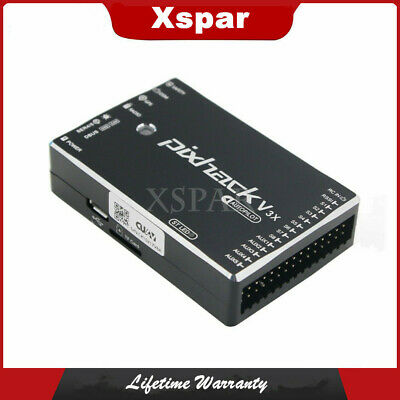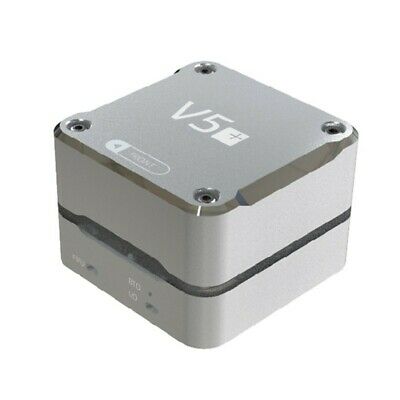-40%
3DR Pixhawk 1 Flight Controller PX4 + GPS + Telemetry + 4GB SD Card + Misc.
$ 56.77
- Description
- Size Guide
Description
The3DR Pixhawk
®
1
autopilot is a popular general purpose flight controller based on the
Pixhawk-project
(opens new window)
FMUv2
open hardware design (it combines the functionality of the PX4FMU + PX4IO). It runs PX4 on the
NuttX
(opens new window)
OS.
Assembly/setup instructions for use with PX4 are provided here:
Pixhawk Wiring Quickstart
#
Key Features
Main System-on-Chip:
STM32F427
(opens new window)
CPU: 180 MHz ARM
®
Cortex
®
M4 with single-precision FPU
RAM: 256 KB SRAM (L1)
Failsafe System-on-Chip: STM32F100
CPU: 24 MHz ARM Cortex M3
RAM: 8 KB SRAM
Wifi: ESP8266 external
GPS: u-blox
®
7/8 (Hobbyking
®
) / u-blox 6 (3D Robotics)
Optical flow:
PX4 Flow unit
Redundant power supply inputs and automatic failover
External safety switch
Multicolor LED main visual indicator
High-power, multi-tone piezo audio indicator
microSD card for high-rate logging over extended periods of time
Connectivity
1x I2C
1x CAN (2x optional)
1x ADC
4x UART (2x with flow control)
1x Console
8x PWM with manual override
6x PWM / GPIO / PWM input
S.BUS / PPM / Spektrum input
S.BUS output
Specifications
#
Processor
32bit STM32F427
Cortex-M4F
(opens new window)
core with FPU
168 MHz
256 KB RAM
2 MB Flash
32 bit STM32F103 failsafe co-processor
#
Sensors
ST Micro L3GD20H 16 bit gyroscope
ST Micro LSM303D 14 bit accelerometer / magnetometer
Invensense MPU 6000 3-axis accelerometer/gyroscope
MEAS MS5611 barometer
#
Interfaces
5x UART (serial ports), one high-power capable, 2x with HW flow control
2x CAN (one with internal 3.3V transceiver, one on expansion connector)
Spektrum DSM / DSM2 / DSM-X® Satellite compatible input
Futaba S.BUS® compatible input and output
PPM sum signal input
RSSI (PWM or voltage) input
I2C
SPI
3.3 and 6.6V ADC inputs
Internal microUSB port and external microUSB port extension
Internal microUSB port and external microUSB port extension
#
Power System and Protection
Ideal diode controller with automatic failover
Servo rail high-power (max. 10V) and high-current (10A+) ready
All peripheral outputs over-current protected, all inputs ESD protected
#
Voltage Ratings
Pixhawk can be triple-redundant on the power supply if three power sources are supplied. The three rails are: Power module input, servo rail input, USB input.
#
Normal Operation Maximum Ratings
Under these conditions all power sources will be used in this order to power the system
Power module input (4.8V to 5.4V)
Servo rail input (4.8V to 5.4V)
UP TO 10V FOR MANUAL OVERRIDE, BUT AUTOPILOT PART WILL BE UNPOWERED ABOVE 5.7V IF POWER MODULE INPUT IS NOT PRESENT
USB power input (4.8V to 5.4V)
#
Absolute Maximum Ratings
Under these conditions the system will not draw any power (will not be operational), but will remain intact.
Power module input (4.1V to 5.7V, 0V to 20V undamaged)
Servo rail input (4.1V to 5.7V, 0V to 20V)
USB power input (4.1V to 5.7V, 0V to 6V)
#
Schematics
FMUv2 + IOv2 schematic
(opens new window)
-- Schematic and layout
Note
As a CC-BY-SA 3.0 licensed Open Hardware design, all schematics and design files are
available
(opens new window)
.
#
Connectors
TIP
The RC IN port is for RC receivers only and provides power.
NEVER
connect any servos, power supplies or batteries to it or to the receiver connected to it.
#
Pinouts
#
TELEM1, TELEM2 ports
Pin
Signal
Volt
1 (red)
VCC
+5V
2 (blk)
TX (OUT)
+3.3V
3 (blk)
RX (IN)
+3.3V
4 (blk)
CTS (IN)
+3.3V
5 (blk)
RTS (OUT)
+3.3V
6 (blk)
GND
GND
#
GPS port
Pin
Signal
Volt
1 (red)
VCC
+5V
2 (blk)
TX (OUT)
+3.3V
3 (blk)
RX (IN)
+3.3V
4 (blk)
CAN2 TX
+3.3V
5 (blk)
CAN2 RX
+3.3V
6 (blk)
GND
GND
#
SERIAL 4/5 port
Due to space constraints two ports are on one connector.
Pin
Signal
Volt
1 (red)
VCC
+5V
2 (blk)
TX (#4)
+3.3V
3 (blk)
RX (#4)
+3.3V
4 (blk)
TX (#5)
+3.3V
5 (blk)
RX (#5)
+3.3V
6 (blk)
GND
GND
#
ADC 6.6V
Pin
Signal
Volt
1 (red)
VCC
+5V
2 (blk)
ADC IN
up to +6.6V
3 (blk)
GND
GND
#
ADC 3.3V
Pin
Signal
Volt
1 (red)
VCC
+5V
2 (blk)
ADC IN
up to +3.3V
3 (blk)
GND
GND
4 (blk)
ADC IN
up to +3.3V
5 (blk)
GND
GND
#
I2C
Pin
Signal
Volt
1 (red)
VCC
+5V
2 (blk)
SCL
+3.3 (pullups)
3 (blk)
SDA
+3.3 (pullups)
4 (blk)
GND
GND
#
CAN
Pin
Signal
Volt
1 (red)
VCC
+5V
2 (blk)
CAN_H
+12V
3 (blk)
CAN_L
+12V
4 (blk)
GND
GND
#
SPI
Pin
Signal
Volt
1 (red)
VCC
+5V
2 (blk)
SPI_EXT_SCK
+3.3
3 (blk)
SPI_EXT_MISO
+3.3
4 (blk)
SPI_EXT_MOSI
+3.3
5 (blk)
!SPI_EXT_NSS
+3.3
6 (blk)
!GPIO_EXT
+3.3
7 (blk)
GND
GND
#
POWER
Pin
Signal
Volt
1 (red)
VCC
+5V
2 (blk)
VCC
+5V
3 (blk)
CURRENT
+3.3V
4 (blk)
VOLTAGE
+3.3V
5 (blk)
GND
GND
6 (blk)
GND
GND
#
SWITCH
Pin
Signal
Volt
1 (red)
VCC
+3.3V
2 (blk)
!IO_LED_SAFETY
GND
3 (blk)
SAFETY
GND
#
Serial Port Mapping
UART
Device
Port
UART1
/dev/ttyS0
IO debug
USART2
/dev/ttyS1
TELEM1 (flow control)
USART3
/dev/ttyS2
TELEM2 (flow control)
UART4
UART7
CONSOLE
UART8
SERIAL4
#
Debug Ports
#
Console Port
The
PX4 System Console
runs on the port labeled
SERIAL4/5
.
The pinout is standard serial pinout, designed to connect to a
3.3V FTDI
(opens new window)
cable (5V tolerant).
3DR Pixhawk 1
FTDI
1
+5V (red)
2
S4 Tx
3
S4 Rx
4
S5 Tx
5
5
S5 Rx
4
6
GND
1
The wiring for an FTDI cable to a 6-pos DF13 1:1 connector is shown in the figure below.
The complete wiring is shown below.
Note
For information on how to
use
the console see:
System Console
.
#
SWD Port
The
SWD
(JTAG) ports are hidden under the cover (which must be removed for hardware debugging). There are separate ports for FMU and IO, as highlighted below.
The ports are ARM 10-pin JTAG connectors, which you will probably have to solder. The pinout for the ports is shown below (the square markers in the corners above indicates pin 1).
Note
All Pixhawk FMUv2 boards have a similar SWD port.
#
Building Firmware
TIP
Most users will not need to build this firmware! It is pre-built and automatically installed by
QGroundControl
when appropriate hardware is connected.
To
build PX4
for this target:
make px4_fmu-v2_default
#
Parts / Housings
ARM MINI JTAG (J6)
: 1.27 mm 10pos header (SHROUDED), for Black Magic Probe: FCI 20021521-00010D4LF (
Distrelec
(opens new window)
,
Digi-Key
(opens new window)
,) or Samtec FTSH-105-01-F-DV-K (untested) or Harwin M50-3600542 (
Digikey
(opens new window)
or
Mouser
(opens new window)
)
JTAG Adapter Option #1:
BlackMagic Probe
(opens new window)
. Note, may come without cables (check with manufacturer). If so, you will need the
Samtec FFSD-05-D-06.00-01-N
cable (
Samtec sample service
(opens new window)
or
Digi-Key Link: SAM8218-ND
(opens new window)
) or
Tag Connect Ribbon
(opens new window)
and a Mini-USB cable.
JTAG Adapter Option #2:
Digi-Key Link: ST-LINK/V2
(opens new window)
/
ST USER MANUAL
(opens new window)
, needs an ARM Mini JTAG to 20pos adapter:
Digi-Key Link: 726-1193-ND
(opens new window)
JTAG Adapter Option #3:
SparkFun Link: Olimex ARM-TINY
(opens new window)
or any other OpenOCD-compatible ARM Cortex JTAG adapter, needs an ARM Mini JTAG to 20pos adapter:
Digi-Key Link: 726-1193-ND
(opens new window)
USARTs
: Hirose DF13 6 pos (
Digi-Key Link: DF13A-6P-1.25H(20)
(opens new window)
)
Mates: Hirose DF13 6 pos housing (
Digi-Key Link: Hirose DF13-6S-1.25C
(opens new window)
)
I2C and CAN
: Hirose DF13 4 pos (
Digi-Key Link: DF13A-4P-1.25H(20)
(opens new window)
)
#
Supported Platforms / Airframes
Any multicopter / airplane / rover or boat that can be controlled with normal RC servos or Futaba S-Bus servos.




















